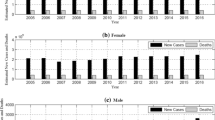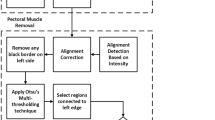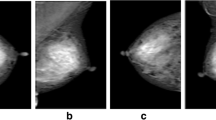Abstract
Purpose
Accurately detecting and removing pectoral muscle areas depicting on mediolateral oblique (MLO) view mammograms are an important step to develop a computer-aided detection scheme to assess global mammographic density or tissue patterns. This study aims to develop and test a new fully automated, accurate and robust method for segmenting pectoral muscle in MLO mammograms.
Methods
The new method includes the following steps. First, a small rectangular region in the top-left corner of the MLO mammogram which may contain pectoral muscle is captured and enhanced by the fractional differential method. Next, an improved iterative threshold method is applied to segment a rough binary boundary of the pectoral muscle in the small region. Then, a rough contour is fitted with the least squares method on the basis of points of the rough boundary. Last, the fitting contour is subjected to local active contour evolution to obtain the final pectoral muscle segmentation line. The method has been tested on 720 MLO mammograms.
Results
The segmentation results generated using the new scheme were evaluated by two expert mammographic radiologists using a 5-scale rating system. More than 65% were rated above scale 3. When assessing the segmentation results generated using Hough transform, morphologic thresholding methods and Unet-based model, less than 20%, 35% and 47% of segmentation results were rated above scale 3 by two radiologists, respectively. Quantitative data analysis results show that the Dice coefficient of 0.986 ± 0.005 is obtained. In addition, the mean rate of errors and Hausdorff distance between the contours detected by automated and manual segmentation are FP = 1.71 ± 3.82%, FN = 5.20 ± 3.94% and 2.75 ± 1.39 mm separately.
Conclusion
The proposed method can be used to segment the pectoral muscle in MLO mammograms with higher accuracy and robustness.











Similar content being viewed by others
References
Yang Q, Li L, Zhang J, Shao G, Zheng B (2015) A new quantitative image analysis method for improving breast cancer diagnosis using DCE-MRI examinations. Med Phys 42(1):103
Aghaei F, Tan M, Hollingsworth AB, Qian W, Liu H, Zheng B (2015) Computer-aided breast MR image feature analysis for prediction of tumor response to chemotherapy. Med Phys 42(11):6520–6528
Lehman CD, Wellman RD, Buist DS, Kerlikowske K, Tosteson AN, Miglioretti DL (2015) Diagnostic accuracy of digital screening mammography with and without computer-aided detection. JAMA Intern Med 175(11):1828
Bandyopadhyay SK, IndraKantaMaitra (2015) Fully automated computer aided diagnosis (CAD) system of human breast cancer using digital mammogram
Vaidehi K, Subashini TS (2015) Automatic classification of CC view and MLO view in digital mammograms. In: Kamalakannan C, Suresh L, Dash S, Panigrahi B (eds) Power electronics and renewable energy systems, vol 326. Springer, New Delhi
Karssemeijer N (1998) Automated classification of parenchymal patterns in mammograms. Phys Med Biol 43(2):365
Ferrari RJ, Rangayyan RM, Desautels JEL, Borges RA, Frere AF (2004) Automatic identification of the pectoral muscle in mammograms. IEEE Trans Med Imaging 23(2):232
Yam M, Brady M, Highnam R, Behrenbruch C, English R, Kita Y (2001) Three-dimensional reconstruction of microcalcification clusters from two mammographic views. IEEE Trans Med Imaging 20(6):479–489
Ma F, Bajger M, Slavotinek JP, Bottema MJ (2007) Two graph theory based methods for identifying the pectoral muscle in mammograms. Pattern Recogn 40(9):2592–2602
Georgsson F (2001) Algorithms and techniques for computer aided mammo-graphic screening. Daily Mail
Makandar A, Halalli B (2016) Threshold based segmentation technique for mass detection in mammography. J Comput 11(6):472–478
Li Y, Chen H, Yang Y, Yang N (2013) Pectoral muscle segmentation in mammograms based on homogenous texture and intensity deviation. Pattern Recogn 46(3):681–691
Hong BW, Sohn BS (2010) Segmentation of regions of interest in mammograms in a topographic approach. IEEE Trans Inf Technol Biomed 14(1):129
Rodriguez-Ruiz A, Teuwen J, Chung K, Karssemeijer N, Chevalier M, Gubern-Mérida A (2018) Pectoral muscle segmentation in breast tomosynthesis with deep learning. In: Computer-aided diagnosis
Chen D, Chen YQ, Xue D, Pan F (2012) Adaptive image enhancement based on fractional differential mask. In: CCDC, vol 229, pp 1043–1047
Erçelebi E, Koç S (2006) Lifting-based wavelet domain adaptive wiener filter for image enhancement. IEE Proc Vis Image Signal Process 153(1):31–36
Wuthrich M, Trimpe S, Kappler D, Schaal S (2015) A new perspective and extension of the Gaussian filter. Comput Sci 35(14)
Anh VV, Mcvinish R (2003) Fractional differential equations driven by Lévy noise. Int J Stoch Anal 16(2):97–119
Yi-Fei PU (2007) Application of fractional differential approach to digital image processing. J Sichuan Univ 39(3):124–132
Pu YF, Zhou JL, Yuan X (2010) Fractional differential mask: a fractional differential-based approach for multiscale texture enhancement. IEEE Trans Image Process 19(2):491
Eklund GW, Cardenosa G, Parsons W (1994) Assessing adequacy of mammographic image quality. Radiology 190(2):297–307
Magid A, Rotman SR, Weiss AM (1990) Comments on picture thresholding using an iterative selection method. IEEE Trans Syst Man Cybern 20(5):1238–1239
Boukamp BA (1986) A nonlinear least squares fit procedure for analysis of immittance data of electrochemical systems. Solid State Ionics 20(1):31–44
Variable, R. (2013). Heaviside step function. Below
Ruotsalainen K, Saranen J (1987) Some boundary element methods using Dirac’s distributions as trial functions. SIAM J Numer Anal 24(4):816–827
Chan TF, Vese L (2001) Active contours without edges. IEEE Trans Image Process 10(2):266
Yezzi A, Tsai A, Willsky A (2002) A fully global approach to image segmentation via coupled curve evolution equations. Academic Press Inc., New York
Mustra M, Grgic M (2013) Robust automatic breast and pectoral muscle segmentation from scanned mammograms. Signal Process 93(10):2817–2827
Ferrari RJ, Rangayyan RM, Desautels JEL, Borges RA, Frere AF (2004) Automatic identification of the pectoral muscle in mammograms. IEEE Trans Med Imaging 23(2):232
Huttenlocher DP, Klanderman GA, Rucklidge WJ (1993) Comparing images using the Hausdorff distance. IEEE Trans Pattern Anal Mach Intell 15(9):850–863
Och FJ, Ney H (2003) A systematic comparison of various statistical alignment models. MIT Press, Cambridge
Acknowledgements
This work was supported by the National Institutes of Health [Grant Numbers R01 CA160205, CA197150].
Author information
Authors and Affiliations
Corresponding author
Ethics declarations
Conflict of interest
The authors declare that they have no conflict of interest.
Ethical approval
This article does not contain any studies with human participants or animal performed by any of the authors.
Rights and permissions
About this article
Cite this article
Yin, K., Yan, S., Song, C. et al. A robust method for segmenting pectoral muscle in mediolateral oblique (MLO) mammograms. Int J CARS 14, 237–248 (2019). https://doi.org/10.1007/s11548-018-1867-7
Received:
Accepted:
Published:
Issue Date:
DOI: https://doi.org/10.1007/s11548-018-1867-7




